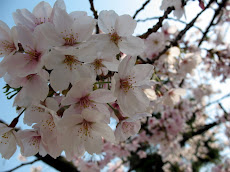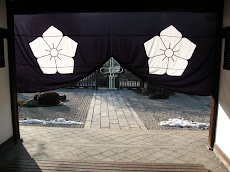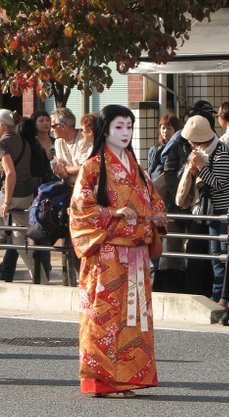Have you read Barbara Kingsolver's new book, Animal, Vegetable, Miracle? If you haven't, go read it. NOW.
You're back? Good. I would be a little ashamed to tell you just how much I learned from that book. I should have known, for instance, how potatoes grow, or how to store things like tomatoes and zucchini when the season is over. (Just freeze them whole, apparently.) Thanks to a summer working in a grocery store, I know when the different summer crops come into season, and how to pick the best fruits or vegetables off the store shelf. Even cantaloupes. And since starting our little garden out back, I've learned quite a lot more. I thought that if I had to start producing a majority of my own food, I could do it. That's what Kingsolver and her family did, for a whole year. The premise appealed to me (though I'm certainly not going to try it anytime soon, my backyard isn't that big) from a gardener's standpoint. Since moving to Japan, I've become interested in growing my own food, since I have the space to do it, it's cheaper, and it's healthier (I don't use pesticides.) I started off with some tomatoes, recalling summers at home spent eating delicious homegrown tomatoes. I added bell peppers, which tend to be expensive here. It snowballed from there. For the winter, we're planting onions, garlic, potatoes, and spinach. Now it's less about the money aspect- I can afford all the onions and potatoes I want. It's more about having that homegrown taste, and lessening my impact on the environment.
I've started reading labels in the grocery store on almost every item I buy. I bought lemons last week. There were two types; each cost about $1. One was imported from Chile, the other two prefectures away in Hiroshima. I don't have any statistics for you, but just think about it: how much fuel did it take to get that fresh lemon from Chile to Japan, keeping it cold the whole way? And how much fuel did it require to get from Hiroshima to my street (a distance of, I don't know, about 150 miles.) It's obvious which choice is better for the environment. I'm not sure why everyone isn't complaining about this, since we sure do enough complaining when it comes to filling up our gas tanks. And we're paying for it- if you're not paying for it at the cash register, you're paying when you pay your taxes, since farms (of any size, I believe) can deduct their transportation expenses. The average item on your grocery store shelf probably traveled farther than you did on your summer vacation this year, according to Animal, Vegetable, Miracle.
The other amazing thing to me is that these lemons cost EXACTLY the same amount, despite the wide difference in cost in getting to my local MaxValu. So which farmer will be getting more of my money? Guess. Which lemon did I buy? That's right.
Being in Japan has made me more aware of things like seasonality and local crops. While the Japanese, like Americans, enjoy the luxury of having everything, all the time, for the most part foods are enjoyed only when they're in season. I have recipe cards that tell me what season I should cook each dish in. At first I thought it was silly, I had a mentality of "I can eat onion soup whenever I want!" and so on. But it makes sense, considering our living situation. In February, no Japanese person would say "Oh, I just want something light tonight, like a salad" and then complain about being cold and turn up the heat to 80 degrees. Because you can't. It is 40 degrees indoors, there is no central heat, and if you don't plan on freezing while you sleep, you had better eat some stew for dinner. I'm not saying it's perfect. If I had the choice, I'd go for the central heat, without a doubt. But I'd make sure to eat lots of stew and take lots of baths in the winter, to save some money and help the environment too.
The Japanese also firmly believe in local specialties, another concept I thought was dumb at first. Just about every city has something they are famous for. A city near me, Akashi, is famous for its particular style of grilled octopus balls (they dip them in broth) and there are countless different types of noodles. Every bag of rice is clearly labeled with its area of origin. People travel to Hokkaido just to try the fresh crabs. To me, it seemed silly, because couldn't anyone make some broth for their octopus balls? Well, they could, but Akasahi is on the Japanese Inland Sea, and they probably use some sort of local seaweed that tastes different from the seaweed that grows near Okinawa or Tokyo. It's widely accepted that wines grown in different regions or even different counties will taste different. Why not food? When I ate crab in Hokkaido this summer, it tasted fresher than any other crab I've had here. There's no substitute for it. When I returned from Hokkaido, my coworker asked me these questions, in order:
Her: Welcome back! Did you have a good trip?
Me: Yes, it was very relaxing.
Her: Did you eat jingus kan? (grilled mutton on sticks, a famous Sapporo dish)
Me: No, but I ate a lot of ramen. (Sapporo is also famous for its style of ramen.)
Her: How about crab?
And so on. And don't forget the number one most important thing of Japanese vacations-- you must bring back o-miyage, or souvenirs. This is ALWAYS food. The idea is that you should bring back some local food for all your coworkers to sample. From various vacations, I have brought back chocolates, chips made out of bitter gourds, fruit-flavored cookies, tofu cookies, bean-filled dumplings, buckwheat pancakes, and so on.
I think that if Barbara Kingsolver were to come to Japan, she would be disappointed that Japanese mothers do not "take the time to roll out the sushi by hand," as she suggests in her book. The only people I know who make sushi are sushi chefs, and no, even in Japan, there is no such thing as a "sushi machine." But she would be pleased to find a- dare I say it?- UNIQUE food culture that is built entirely upon eating local food, in season.
Wednesday, September 10, 2008
Subscribe to:
Posts (Atom)



